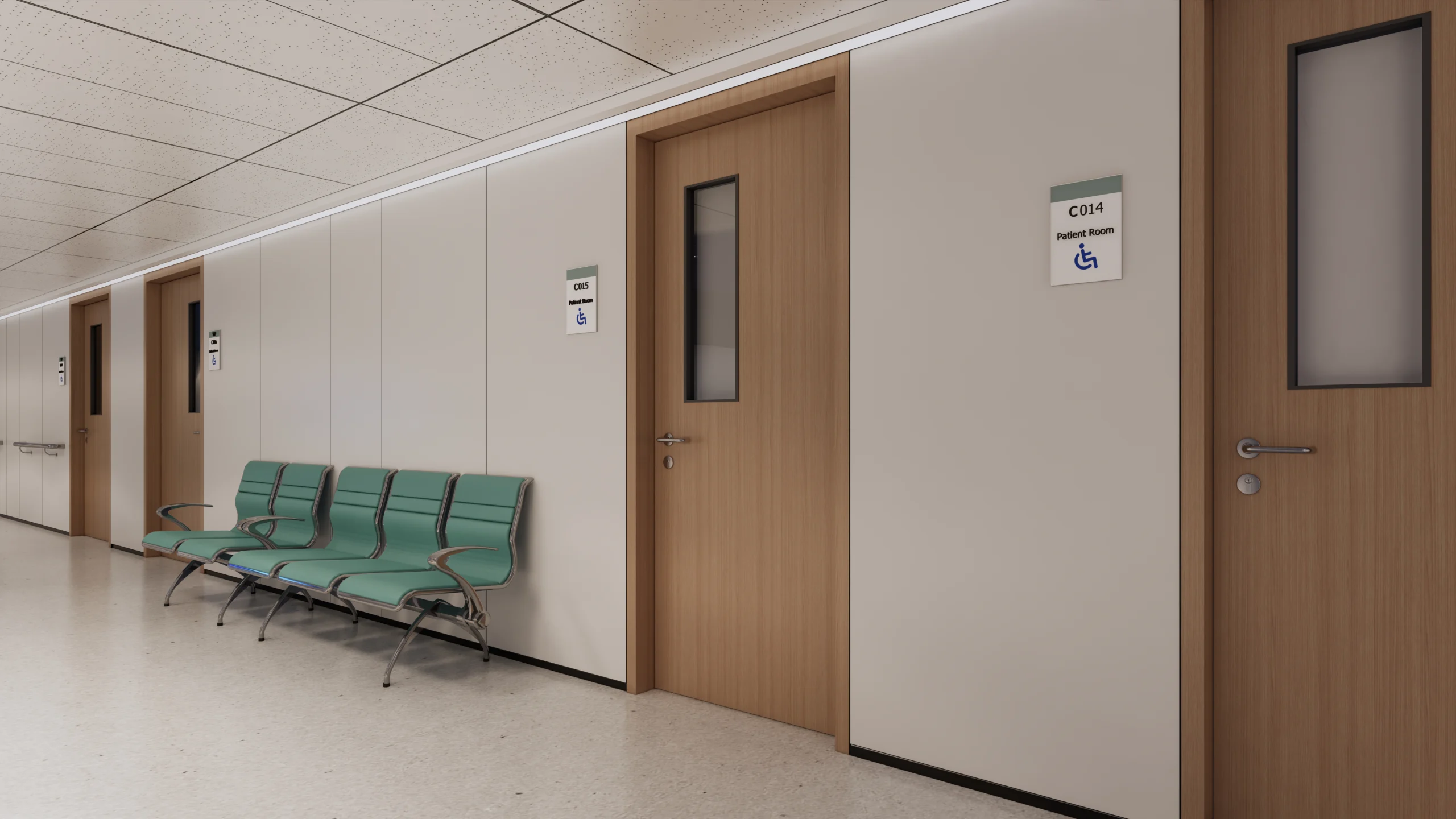Custom Your Hospital Fire Door Project
Hospital Fire Door Introduction

Key Features and Functions
Fire Protection
Hospital fire doors effectively prevent the spread of fire by isolating fire sources, ensuring that critical areas like patient wards, operating rooms, and pharmaceutical storage remain protected.
Durability
Made from high-strength, corrosion-resistant materials, hospital fire doors are designed to withstand high temperatures for extended periods, ensuring long-lasting performance.
Hospital Safety
These fire doors are essential for safeguarding the lives of patients, staff, and visitors, particularly during emergency evacuation scenarios.
Sound Insulation
In addition to offering fire protection, hospital fire doors are also designed with soundproof features to reduce noise disruptions to patients.
Antibacterial Coating
Given the stringent hygiene standards in hospitals, the surface of fire doors is often coated with antibacterial layers to prevent the growth of bacteria.
Meets Hospital Building Codes
Hospital fire doors meet international and local fire safety standards and comply with fire protection, evacuation, and ventilation regulations in building design.
Design Your Hospital Fire Door Projects With Experts
Core Advantages of Hospital Fire Doors
Key Features for Safety Protection
Fire Resistance
Hospital fire doors are built to withstand extreme temperatures for extended periods. Depending on the fire rating (e.g., 60 minutes, 90 minutes, or even 120 minutes), these doors can effectively contain the fire in one area, preventing it from spreading to other parts of the building, particularly critical areas such as operating rooms, intensive care units, and patient wards.
Safe Evacuation Time
The primary purpose of these doors is to delay the spread of fire, providing crucial time for medical staff to evacuate patients and move them to safer areas. Hospital fire doors help ensure that patients who cannot evacuate independently (due to medical conditions or immobility) are kept secure until rescued.
Smoke Containment
Besides blocking fire, these doors also serve as barriers to smoke, which can be just as deadly in a fire. Containing smoke helps improve air quality, giving patients and medical personnel more time to escape or respond to an emergency.
Emergency Functionality
Hospital fire doors often have automatic closing mechanisms or smoke sealing systems that ensure they close when needed, even in chaotic environments. This automatic response reduces human error and enhances safety.
Meeting the Unique Demands of Hospital Environments
Key Features for Hospital-Specific Needs
Sound Insulation
Hospitals are places of rest and healing, so minimizing noise disruptions is crucial. Hospital fire doors are designed with superior sound insulation properties to reduce noise from adjacent areas, such as corridors, busy waiting rooms, or medical equipment areas. This helps create a quieter, more peaceful environment for patients, essential for recovery and overall well-being.
Corrosion Resistance
The hospital environment can be highly demanding, with a constant need for sanitation. Hospital fire doors are made from materials resistant to corrosion, particularly in areas with high cleaning agents, moisture, and humidity levels. This ensures that the doors maintain structural integrity and fire resistance over time, even in harsh conditions.
Antibacterial Coatings
In medical environments, cleanliness is a top priority. Hospital fire doors are often coated with antibacterial materials that help reduce the spread of harmful germs and bacteria. These coatings prevent the growth of pathogens, ensuring that the door surfaces remain hygienic, especially in patient-sensitive areas like surgical suites, isolation rooms, or intensive care units.
Aesthetic Integration
Hospital fire doors are designed for safety and to blend seamlessly with the hospital’s interior design. They come in various finishes, including wood veneer or steel options, that match the aesthetic needs of modern healthcare facilities. Hospitals often aim for a calm and welcoming environment, and fire doors are available in styles that complement this goal.
Durability and Low Maintenance
Given the high traffic in hospitals, fire doors must be durable and withstand daily wear and tear. These doors are built with robust materials and features that require minimal maintenance, allowing them to continue functioning optimally without constant repairs or replacements. This durability ensures the hospital is consistently prepared for emergencies without additional maintenance costs.
Key Features for Hospital-Specific Needs
Patient Comfort and Well-being
Hospital fire doors directly contribute to patient comfort by reducing noise and maintaining a clean environment. Studies show that quieter hospital environments can significantly improve patient recovery and reduce stress.
Compliance with Health and Safety Standards
Hospitals must comply with strict health and safety regulations. Hospital fire doors are designed to meet or exceed all local, national, and international standards for fire protection, hygiene, and accessibility. This ensures that hospitals remain compliant with regulations and maintain a high standard of safety and care.
Long-Term Value
These fire doors' durability and low-maintenance design make them a cost-effective long-term investment for hospitals. Their high performance and minimal upkeep ensure that hospitals receive ongoing value without incurring constant repair or replacement costs.
Hospital Requirements and Regulations
Regulatory Requirements
- Fire Door Rating: The fire doors within a hospital should meet clear fire resistance standards, typically 30 minutes to 120 minutes, to prevent fire spread and provide adequate time for evacuation. Fire Safety Laws and
- Building Codes: According to fire safety design codes and building regulations, hospital fire doors must be fireproof, smoke-resistant, and heat-insulating to ensure effective containment of a fire and safe evacuation in the event of a fire.
- Evacuation Route Requirements: Hospitals must provide adequate escape routes and emergency exits, and the doors leading to these routes must comply with safety codes to ensure quick and effective evacuation while allowing emergency personnel easy access.
Specific Hospital Needs
- Frequent Usage: Fire doors in hospitals must be designed to withstand frequent use, especially in high-traffic areas such as patient rooms, emergency departments, and operating rooms. Durability is key. Patient and
- Healthcare Worker Safety: Hospital fire doors must be designed to meet patient needs, especially for those with limited mobility. The ease of operation, accessibility, and emergency features must be considered to ensure patient and healthcare workers’ safety.
Compliance Verification
Hospital Requirements and Regulations
How Fire Doors Reduce Fire Risk
- Containment of Flames and Smoke: During the early stages of a fire, fire doors are designed to block the spread of flames and toxic smoke, significantly reducing the risk of fire spreading throughout the building.
- Protection of Critical Areas: Fire doors can isolate critical areas in a hospital, such as patient rooms, operating theaters, drug storage rooms, and electrical rooms, thus preventing the fire from affecting these high-risk areas.
- Smoke Containment: Fire doors must also have smoke-resistant properties to prevent the spread of smoke, which is a leading cause of injury and death during a fire. This feature is especially important in hospital settings where smoke inhalation can exacerbate patient conditions.
How Fire Doors Protect Hospital Property
- Reducing Property Loss: By containing fire and smoke, fire doors help protect the hospital’s medical equipment, drugs, and vital records, minimizing the financial impact of a fire disaster.
- Securing Data and Equipment: Hospitals often store sensitive patient data and medical records. Fire doors can protect these critical assets from fire damage, ensuring the integrity and availability of hospital information.
Compliance Verification
- Providing Time for Evacuation: Fire doors delay the spread of fire, giving hospital staff, patients, and visitors enough time to evacuate safely. This is crucial in a hospital where patients cannot evacuate independently.
- Ensuring Safe Evacuation: Fire doors help ensure that escape routes are clear and safe, especially for patients with mobility impairments or needing medical assistance. They make it easier for emergency personnel to evacuate patients and gain access to those in need.
Supporting Data
- Fire Containment Time: Studies have shown that buildings with high-quality fire doors can delay fire spread for 30 to 60 minutes, providing critical time for evacuation and firefighting efforts.
- Reduced Casualty Rates: Fire safety data indicates that buildings without fire doors or inadequate fire doors tend to have higher injury and death rates, especially in crowded areas like hospitals, where the risk of mass casualties increases.
Discover Your Perfect Hospital Fire Door Now
Hospital Fire Door Qualification Certificate Certification
Fire Certifications
- UL Certification(UL10B& 10C): Complies with Underwriters Laboratories standards, demonstrating the door’s performance under high temperatures.
- BS 476: Adheres to British standards, ensuring the door effectively blocks flames and smoke for a specified duration.
- EN 1634-1: Meets European standards for fire resistance, testing the door’s performance over various time periods.
- NFPA 252: National Fire Protection Association standard that validates the overall fire performance of the door.
- AS 1905.1: Complies with Australian standards, ensuring the door’s effective fire resistance under specific conditions.
Manufacturing Standards
- ISO 9001: Quality management system certification that ensures high-quality standards throughout the production process.
- ISO 14001: Environmental management system certification that adheres to eco-friendly practices, minimizing environmental impact.
- ISO 45001: Occupational health and safety management system certification, ensuring the safety and health of employees during production.
- FSC Certification: We use wood sourced from sustainably managed forests, ensuring environmental responsibility and resource sustainability.
- CE Marking: Our products are CE marked, indicating they comply with European health, safety, and environmental protection standards.
What They Say






FAQ
Choose doors that are certified to meet local fire safety regulations, such as NFPA 80 in the US or BS 476 in the UK. Look for certifications like UL, WH, or CE for guaranteed compliance.
- Fire Resistance Rating: Select a door that meets the required fire resistance rating based on the hospital's fire safety plan. Sealing
- Performance: Ensure that the door has proper seals to prevent smoke and fire from passing through.
- Ease of Operation: Fire doors should be easy for healthcare personnel and patients to use, especially during emergencies.
- Compliance: Choose fire doors that comply with local fire safety regulations and standards.
- Checking for any damage to the door itself.
- Inspecting the door frame and seals for integrity.
- Ensuring proper function of door locks, hinges, and other hardware.
- Testing the door's opening and closing mechanism ensures it operates smoothly during an emergency.
- Proper Placement: Fire doors should be installed in critical areas, such as patient rooms, corridors, and evacuation routes.
- Compliance with Regulations: Ensure the installation meets national or regional fire safety standards.
- Professional Installation: Have the doors installed by certified professionals to ensure proper sealing and safety.
